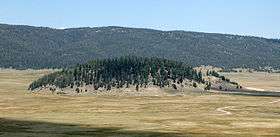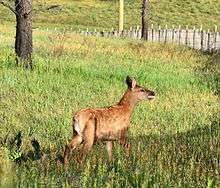Valles Caldera
| Valles Caldera | |
|---|---|
 Cerro la Jara, an approximately 75-metre (246 ft) high forested rhyolite lava dome within the caldera. | |
| Highest point | |
| Elevation | 11,253 ft (3,430 m) [1] |
| Coordinates | 35°54′N 106°32′W / 35.900°N 106.533°WCoordinates: 35°54′N 106°32′W / 35.900°N 106.533°W |
| Geography | |
 Valles Caldera Location in New Mexico | |
| Location | Sandoval County, New Mexico, US |
| Parent range | Jemez Mountains |
| Geology | |
| Mountain type | Complex Caldera |
| Volcanic arc/belt | Jemez Lineament and Rio Grande Rift |
| Last eruption | 50,000–60,000 yrs BP[1] |
| Climbing | |
| Easiest route | New Mexico State Road 4 |
| Designated | 1975 |
Valles Caldera (or Jemez Caldera) is a 13.7-mile (22.0 km) wide volcanic caldera in the Jemez Mountains of northern New Mexico.[1] Hot springs, streams, fumaroles, natural gas seeps and volcanic domes dot the caldera floor landscape.[2] The highest point in the caldera is Redondo Peak, an 11,253-foot (3,430 m) resurgent lava dome located entirely within the caldera. Also within the caldera are several grass valleys [Valle(s)] the largest of which is Valle Grande (locally /ˈvaɪ.eɪ ˈɡrɑːndeɪ/ VY-ay GRAHN-day), the only one accessible by a paved road. Much of the caldera is within the Valles Caldera National Preserve, a unit of the National Park System.
History
Use of Valles Caldera dates back to the prehistoric times: spear points dating to 11,000 years ago have been discovered.[3] Several Native American tribes frequented the caldera, often seasonally for hunting and for obsidian, used for spear and arrow points. Obsidian from the caldera was traded by tribes across much of the Southwest. Eventually, Spanish and later Mexican settlers as well as the Navajo and other tribes came to the caldera seasonally for grazing with periodic clashes and raids. Later as the United States acquired New Mexico as part of the Treaty of Guadalupe Hidalgo in 1848, the caldera became the backdrop for the Indian wars with the U.S Army. Around the same time, the commercial use of the caldera for ranching, and its forest for logging began.
Baca Ranch
The caldera became part of the Baca Ranch in 1876. The Bacas were a wealthy family given the land as compensation for the termination of a grant given to their family near Las Vegas, in northeastern New Mexico. The family was given several other parcels by the US Government as well, including one in Arizona. This area, 100,000 acres, was called Baca Location number one. Since then, the land has been through a string of exchanges between private owners and business enterprises. Most notably, it was owned by Frank Bond in the 1930s. Mr. Bond, a businessman based in nearby Española, ran up to 30,000 sheep in the calderas, significantly overgrazing the land and causing damage from which the watersheds of the property are still recovering.
The land was purchased by the Dunigan family from Abilene, Texas in 1963. Pat Dunigan did not obtain the timber rights, however, and the New Mexico Lumber Company logged the property very heavily, leaving the land scarred with roads and removing significant amounts of old-growth douglas fir and ponderosa pine. Mr. Dunigan bought out the timber rights in the 1970s and slowed the logging. He negotiated unsuccessfully with the National Park Service and the US Forest Service for possible sale of the property in the 1980s.[3]

Valles Caldera National Preserve
The Valles Caldera Preservation Act of 2000 signed by President Clinton on July 25, 2000, created the Valles Caldera National Preserve (VCNP).[4] The legislation provided for the federal purchase of this historical ranch nestled inside a volcanic caldera, with funds coming from the Land and Water Conservation Fund (LWCF) derived from royalties the US government receives from offshore petroleum and natural gas drilling.[2] The Dunigan family sold the entire surface estate of 95,000 acres (380 km2) and seven-eighths of the geothermal mineral estate to the federal government for $101 million. As some sites of the Baca Ranch are sacred and of cultural significance to the Native Americans, 5,000 acres (20 km2) of the purchase were obtained by the Santa Clara Pueblo, which borders the property to the northeast. This include the headwaters of Santa Clara Creek that is sacred to the pueblo.[2][3] On the southwest corner of the land 300 acres (1.2 km2) were to be ceded to Bandelier National Monument.
2011 wildfire
In July 2011, the Las Conchas Fire started by a power line on nearby private land, burned 30,000 acres (120 km2) of the Valles Caldera National Preserve. The wildfire burned a total of 158,000 acres (640 km2) in the Jemez Mountains, including most of neighboring Bandelier National Monument.
Geology and science


Valles Caldera is one of the smaller volcanoes in the supervolcano class. The circular topographic rim of the caldera measures 13.7 miles (22.0 km) in diameter.[1] The caldera and surrounding volcanic structures are one of the most thoroughly studied caldera complexes in the United States. Research studies have concerned the fundamental processes of magmatism, hydrothermal systems, and ore deposition. Nearly 40 deep cores have been examined, resulting in extensive subsurface data.
Valles Caldera is the younger of two calderas known at this location, having collapsed over and buried the older Toledo Caldera, which in turn may have collapsed over yet older calderas. The associated Cerros del Rio volcanic field, which forms the eastern Pajarito Plateau and the Caja del Rio, is older than the Toledo Caldera. These two large calderas formed during eruptions 1.47 million and 1.15 million years ago.[5] The caldera and surrounding area continue to be shaped by ongoing volcanic activity. The El Cajete Pumice, Battleship Rock Ignimbrite, Banco Bonito Rhyolite, and the VC-1 Rhyolite were emplaced during the youngest eruption of Valles Caldera, about 50,000–60,000 years ago. Seismic investigations show that a low-velocity zone lies beneath the caldera, and an active geothermal system with hot springs and fumaroles exists today.[1]
The lower Bandelier tuff which can be seen along canyon walls west of Valles Caldera, including San Diego Canyon, is related to the eruption and collapse of Toledo Caldera. The upper Bandelier tuff is believed to have been deposited during eruption and collapse of Valles Caldera. The now eroded and exposed orange-tan, light-colored Bandelier tuff from these events creates the stunning mesas of the Pajarito Plateau.
These calderas and associated volcanic structures lie within the Jemez Volcanic Field. This volcanic field lies above the intersection of the Rio Grande Rift, which runs north-south through New Mexico, and the Jemez Lineament, which extends from southeastern Arizona northeast to western Oklahoma. The volcanic activity here is related to the tectonic movements of this intersection.
Geothermal energy source potential
The volcanic properties of Valles Caldera make it a likely source for renewable and nonpolluting geothermal energy. However, some people oppose the development of geothermal energy, considering it destructive to its scenic beauty, recreational and grazing use. Its impact on the hot springs and supplying aquifers is unknown as experiences from other past geothermal projects proved that production of reservoir fluids had dramatic impacts to the surface thermal features.[6]

Recreation
A number of recreational and/or historical uses take place in Valles Caldera. Many of these uses involve trails. Valles Caldera has many miles of ranch roads, livestock and game trails. These include a network of trails currently designated for horse riding.[7][8] Historically, Valles Caldera was a location for equestrian endurance races. After establishment of VCNP, the first race in the caldera was held in 2009. The largest grass valley, Valle Grande, is a venue for ski orienteering. Activities are open to the public, though some require reservations. Customer service and concierge services are provided by the Public Lands Interpretive Association.
Wildlife and livestock
Throughout the caldera, the grass valleys appear groomed: there are few saplings and mature trees lack lower branches. This is due to heavy browsing by elk and cattle and because of frequent grass fires of human and natural origin which kill the lower branches on the Engelmann spruce, Douglas-fir and Ponderosa pine that populate the uplands around the grasslands dominating the bottoms of the calderas. Extreme cold in winter prevents tree growth in the bottoms of the calderas. The grasslands were native perennial bunch grass maintained by frequent fire before sheep and cattle grazing. Although the grass appears abundant, it is a limited resource. Its growing season is short. Through the VCNP's limited grazing program, it feeds hundreds of cattle in the summer and thousands more of elk in the warm seasons and in drought winters, and during most of the year. Its nutritional value is low.
Films shot in Valles Caldera

Valles Caldera has provided several filming locations,[9] most for films in the Western genre. Some of these locations include exterior sets, such as the weathered "ranch house" that can be seen from the highway in Valle Grande, and a small "town".
- 1971 Shoot Out
- 1977 Peter Lundy and the Medicine Hat Stallion (TV)
- 1982 The Gambler (TV)
- 1994 Troublemakers
- 1995 Buffalo Girls (TV)
- 1997 Last Stand at Saber River (TV)
- 2003 The Missing
- 2007 Seraphim Falls[10]
- 2013 The Lone Ranger
- 2012-2017 Longmire (TV series)[11]
See also
| Wikimedia Commons has media related to Valles Caldera. |
Notes
- 1 2 3 4 5 "Valles Caldera". Global Volcanism Program. Smithsonian Institution. Retrieved 2013-04-03.
- 1 2 3 Environmental News Network Staff (2000-07-17). CNN.com "New Mexico's Baca Ranch soon to be public land". CNN.com. Retrieved on 2013-04-03.
- 1 2 3 Anscheutz, Kurt F. and Merlan, Thomas (2007). "More than a scenic mountain landscape: Valles Caldera National Preserve land use history". U.S. Department of Agriculture Rocky Mountain Research Center, Fort Collins, CO
- ↑ "Public Law 106–248 - 106th Congress". Valles Caldera National Preserve. Retrieved on 2013-04-04.
- ↑ Izett, Glen A. (1981). "Volcanic Ash Beds: Recorders of Upper Cenozoic Silicic Pyroclastic Volcanism in the Western United States". Journal of Geophysical Research. 86 (B11): 10200–10222. Bibcode:1981JGR....8610200I. doi:10.1029/JB086iB11p10200.
- ↑ Goff, Fraser (2002-12). "Geothermal Potential of Valles Caldera, New Mexico". Geo-Heat Center, Oregon Institute of Technology. Retrieved on 2013-04-03.
- ↑ "Valles Caldera National Preserve (2004) Stewardship Register: Interim Equestrian Program" (PDF). Valles Caldera National Preserve. 2004.
- ↑ "Trail Riding Overview". Valles Caldera National Preserve.
- ↑ Martin, Craig (2003). Valle Grande: A History of the Baca Location No. 1, All Season Publishing.
- ↑ Hephner, Tracy (2006) See Us on the Silver Screen (Again!), La Ventana en los Valles, volume 1, number 2, page 3.
- ↑ Cowboys, Mobsters, and Concierge Doctors; Markee Mag; October 27, 2012.
Further reading
- Fraser Goff, Valles Caldera: A Geologic History. 2009, University of New Mexico Press. ISBN 978-0-8263-4590-5. Review at New Mexico Magazine: "No matter your interest in the Valles Caldera, you’ll learn something new in Fraser Goff’s new book."
External links
- Valles Caldera National Preserve, official website
- The Physics Institute of Brazil's Valles Caldera website (English)
- Geologic travel guide from American Geological Institute
- Caldera Action, advocacy organization
-
 Valles Caldera National Preserve travel guide from Wikivoyage
Valles Caldera National Preserve travel guide from Wikivoyage
